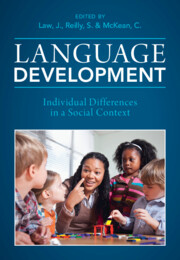Book contents
- Language Development
- Language Development
- Copyright page
- Contents
- Figures
- Tables
- Contributors
- A Tribute to Our Friend, Colleague and Fellow Editor, Professor James Law
- Introduction
- Part One Factors Influencing Language Development
- 3 Genetic Studies of Language Disorders
- 4 Hearing and Language
- 5 Co-occurrence between Language Disorders and Common Conditions in Childhood
- 6 Language and Cognition
- 7 Growing Up in Multilingual Communities
- 8 Parent–Child Interaction and Its Impact on Language Development
- 9 Cognitive Competencies and Signals of Risk
- 10 Creating Equitable Opportunities for Language and Literacy Development in Childhood and Adolescence
- Part Two Continuity and Change
- Part Three Impact, Intervention and Equity
- Index
- References
8 - Parent–Child Interaction and Its Impact on Language Development
from Part One - Factors Influencing Language Development
Published online by Cambridge University Press: 11 August 2022
- Language Development
- Language Development
- Copyright page
- Contents
- Figures
- Tables
- Contributors
- A Tribute to Our Friend, Colleague and Fellow Editor, Professor James Law
- Introduction
- Part One Factors Influencing Language Development
- 3 Genetic Studies of Language Disorders
- 4 Hearing and Language
- 5 Co-occurrence between Language Disorders and Common Conditions in Childhood
- 6 Language and Cognition
- 7 Growing Up in Multilingual Communities
- 8 Parent–Child Interaction and Its Impact on Language Development
- 9 Cognitive Competencies and Signals of Risk
- 10 Creating Equitable Opportunities for Language and Literacy Development in Childhood and Adolescence
- Part Two Continuity and Change
- Part Three Impact, Intervention and Equity
- Index
- References
Summary
It has become increasingly accepted that language development is a product of both neurobiology and the environment. These intersect at the point of daily language interactions between parent and child, whereby language learning occurs through the interaction of a child’s genetically based characteristics and the child’s language experience. This chapter provides the reader with an overview of research on parent–child interaction and language development and considers important interaction features related to early language acquisition, in particular maternal responsiveness. The chapter also explores issues around measures of parent–child interaction, as, traditionally, observational measures of parent–child interaction have been expensive and time-consuming, limiting the use of these measures to small clinical samples. The development of new technologies has improved our ability to reliably measure parent–child interaction, enabling researchers to collect parent–child interaction data in larger samples, assisting us to understand the contribution of different features of parent–child interaction to language development at a population level. This chapter also provides insights into the long-term contributions of early parent–child interaction to child language and learning outcomes from a large community-based sample of mother–child dyads.
Keywords
Information
- Type
- Chapter
- Information
- Language DevelopmentIndividual Differences in a Social Context, pp. 166 - 192Publisher: Cambridge University PressPrint publication year: 2022
References
Accessibility standard: Unknown
Why this information is here
This section outlines the accessibility features of this content - including support for screen readers, full keyboard navigation and high-contrast display options. This may not be relevant for you.Accessibility Information
- 5
- Cited by
